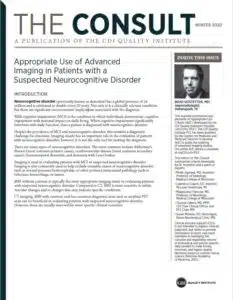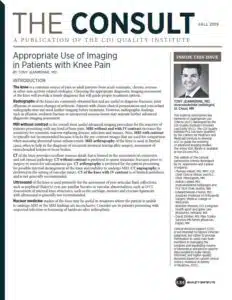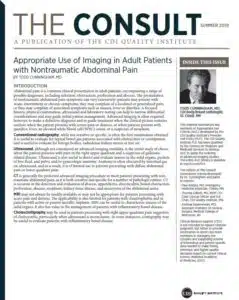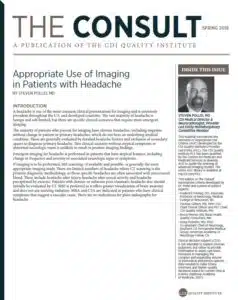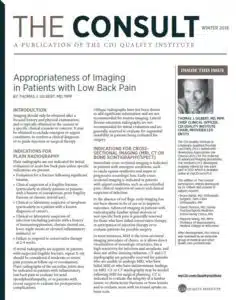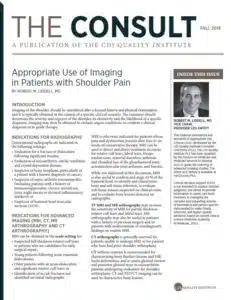Tools and Resources to Optimize Patient Care
As your partner in medical imaging, we’ve developed tools and resources to promote quality and continuity of care. The Consults below are authored by subspecialized radiologists and reviewed by a panel of experts, to provide the most up-to-date evidence-based information to help ensure that the right imaging test is completed at the right time to guide patient care.
-
Appropriateness of Advanced Imaging Procedures in Patients With Rhinosinusitis
Acute rhinosinusitis, generally defined as an episode lasting less than 4 weeks,
is usually diagnosed by history and physical examination. Advanced imaging tests
are not recommended unless the condition persists despite treatment or there
is a suspected complication. When the acute rhinosinusitis is recurrent (four or
more episodes per year), imaging with CT can be useful to confirm the diagnosis,
plan for surgical intervention, and/or identify suspected complications. -
Appropriate Use of Advanced Imaging in Patients with Renal, Adrenal & Urinary Tract Conditions
This edition of The Consult summarizes: Appropriate Use of Advanced Imaging in Patients with Renal, Adrenal & Urinary Tract Conditions. Topics covered include suspected or known calculi, suspected infection, hematuria, incidental renal mass, and incidental adrenal mass.
-
Appropriate Use of Advanced Imaging in Patients with a Suspected Neurocognitive Disorder
There are many types of neurocognitive disorders. The most common include Alzheimer’s disease (most common primary cause), cerebrovascular disease (most common secondary cause), frontotemporal dementia, and dementia with Lewy bodies. Imaging is used in evaluating patients with MCI or suspected neurocognitive disorder.
- Appropriate Use of Imaging in Patients with Knee Pain
-
Appropriate Use of Imaging in Adult Patients with Nontraumatic Abdominal Pain
Abdominal pain is a common clinical presentation in adult patients, encompassing a range of possible diagnoses, including infection, obstruction, perforation and abscess. The presentation of nontraumatic abdominal pain symptoms can vary extensively: patients may present with acute, intermittent or chronic symptoms; they may complain of a localized or generalized pain; or they may complain of associated symptoms such as nausea, fever or diarrhea. A focused history, physical examination, ultrasound and laboratory testing can help to narrow differential considerations and may guide initial patient management. Advanced imaging is often required, however, to make a definitive diagnosis and to guide treatment when the clinical picture remains unclear, when the patient presents with severe pain or distress, or when patients present with jaundice, fever, an elevated white blood cell (WBC) count, or a suspicion of neoplasm.
-
Appropriate Use of Imaging in Patients with Headache
The majority of patients who present for imaging have chronic headaches, including migraine without change in pattern or primary headaches, which do not have an underlying medical condition. These are generally evaluated by detailed headache history and exclusion of secondary causes to diagnose primary headache. This clinical scenario without atypical symptoms or abnormal neurologic exam is unlikely to result in positive imaging findings.
Emergent imaging for headache is performed in patients that have atypical features, including change in frequency and severity or associated neurologic signs or symptoms.
-
Appropriateness of Imaging in Patients with Low Back Pain
Imaging should only be obtained after a focused history and physical examination, and is typically obtained in the context of a specific clinical scenario or concern. It may be obtained to exclude emergent or urgent conditions, to confirm a clinical diagnosis or to guide injection or surgical therapy.
-
Appropriate Use of Imaging in Patients with Shoulder Pain
Imaging of the shoulder should be considered after a focused history and physical examination, and it is typically obtained in the context of a specific clinical scenario. The examiner should determine the severity and urgency of the disorder, its chronicity and the likelihood of a specific diagnosis. Imaging may then be obtained to exclude urgent conditions, to confirm a clinical diagnosis or to guide therapy.
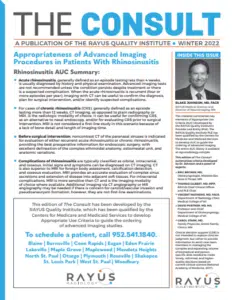 Acute rhinosinusitis, generally defined as an episode lasting less than 4 weeks,
Acute rhinosinusitis, generally defined as an episode lasting less than 4 weeks,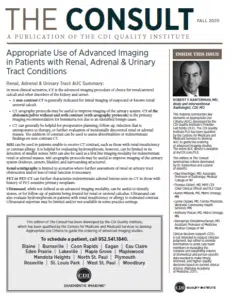 This edition of The Consult summarizes: Appropriate Use of Advanced Imaging in Patients with Renal, Adrenal & Urinary Tract Conditions. Topics covered include suspected or known calculi, suspected infection, hematuria, incidental renal mass, and incidental adrenal mass.
This edition of The Consult summarizes: Appropriate Use of Advanced Imaging in Patients with Renal, Adrenal & Urinary Tract Conditions. Topics covered include suspected or known calculi, suspected infection, hematuria, incidental renal mass, and incidental adrenal mass.